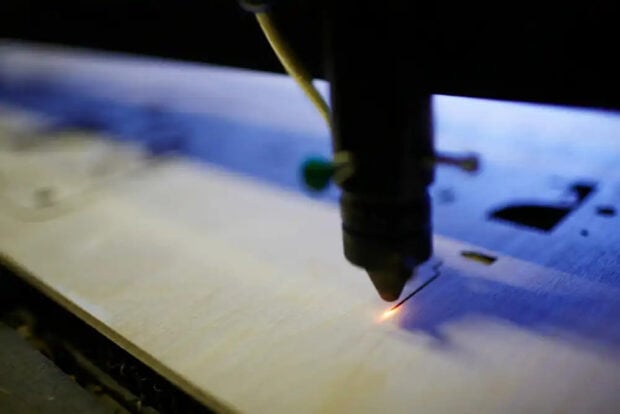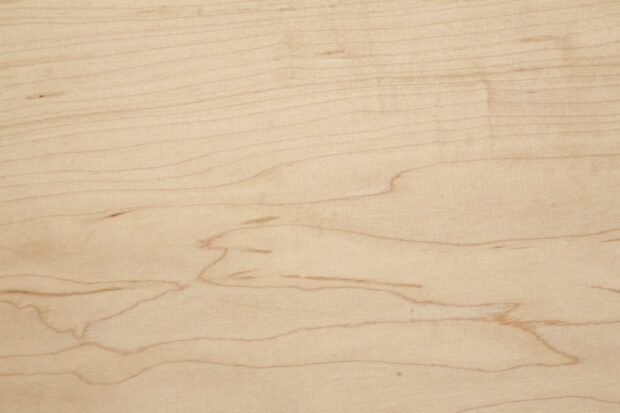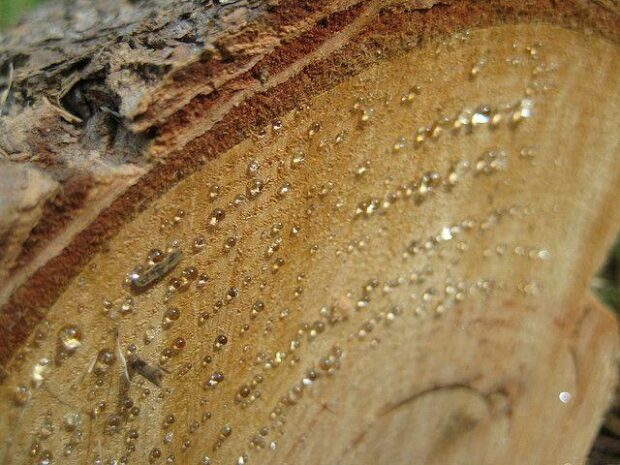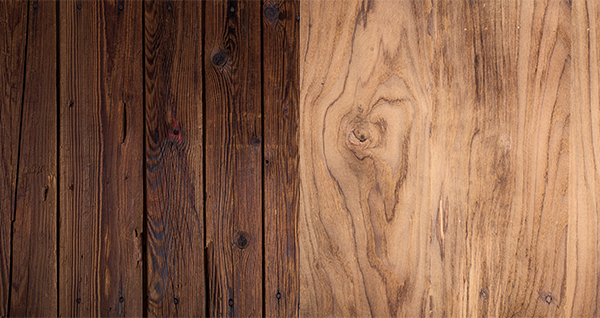Whether for furniture, decorations, or sculptures, wood is a beautiful, affordable, and versatile material for laser engraving. Although many wood types can be used, the best wood for laser cutting should have a light color with minimal streaking.
Not sure what to use for your laser engraving projects?
Wood is popular among artisans and crafters, but not all wood types are equal.
I’ll discuss the best woods you can use for laser engraving and the factors to consider before engraving wood.
Best Wood for Laser Engraving Projects

There are many wood options to use — whether you’re laser cutting for a handmade gift, a small business, or simply as a personal project.
For beginners, I suggest using any of the following woods to help you get started:
1. Alder Wood
Alder wood is a softwood with a supple texture and light streaking.
It has a light color that burns dark, creating a beautiful laser engraving with great contrast.
Alder wood may come with a few knots, but they typically don’t affect the clarity of the engraving. They make for a charming rustic aesthetic!
Lightweight and easy to carve, it remains a favorite of many laser engravers.
2. Cherry Wood
Cherry wood is arguably the most prized hardwood of choice for furniture in the U.S.
Known for its durability and resistance to decay, this wood also lends itself well to laser cutting.
Pink when first cut, it eventually darkens into a rich reddish brown that can create the most stunning laser engraving.
Cherry wood also has a consistent grain and low resin content, but tends to be prone to streaks.
It can be the best wood to laser cut for its attractive color and sturdiness, though it’s relatively PRICIER than other woods.
3. Maple Wood

Used everywhere — from furniture to flooring — this wood product is as durable as it is elegant.
Hard maple is a light-toned wood with an even grain perfect for detailed engravings like photo laser cutting.
Due to its light tone and minimal streaks, it produces a dark burn that can truly make your designs POP.
Although hard maple can be harder to work with than cherry, it has a fine texture that finishes beautifully.
4. Engineered Woods
Real wood is great for laser cutting, but engineered wood can also give you outstanding results.
Engineered woods are made from plastic and natural material from trees.
Here are some selections you can play around with:
Birch Plywood
Arguably the best plywood for laser cutting, birch plywood is a fine-grained material that produces a stunning design.
High-quality plywood is incredibly robust and resists changes and warping no matter the season.
Basswood
For a lightweight and workable wood, basswood is worth trying out. It is one of the most popular plywood for carving because it cuts and stains easily.
Balsa
Balsa is softer than basswood, making it easier to carve and cut.
However, it has a notably coarse texture and can be prone to dents. Nevertheless, it stains and finishes beautifully.
Veneer
Veneers are derived from thin wooden slices from natural hardwood or bark.
The benefit of veneers is that they can be cut quickly with great accuracy due to their low thickness.
Thin wooden substitutes like veneer are also relatively CHEAPER than natural woods.
Factors to Consider When Choosing the Best Wood for Laser Engraving
The natural inconsistencies in wood can make a significant difference in the finished product. The same wood you used last week may not always give you the same result.
Finding the right wood material is KEY to achieving the look you want.
Consider the following factors when selecting wood for your business or DIY projects:
1. Resin Content

Wood naturally releases resin or sap content. Resin is a viscous substance used for a variety of purposes in manufacturing.
The resin content is an important factor that determines how the wood burns when hit with a laser beam.
Resinous wood species or soft wood trees produce more resin content.
On the other hand, non-resinous trees, like alder, birch, and walnut, have less resin content.
A high resin content means a DARKER BURN. It produces a dark engraving with more edge burn that can affect clarity.
Meanwhile, low resin will yield a lighter color with MINIMAL BURN and a clearer engraving.
Cutting the whole or upper portion of the tree, or during colder seasons, can also affect the resin content.
If you want a dark burn, choose wood with high resin content. Otherwise, go for a wood species with low resin content for less burning.
2. Wood Grain
The wood grain refers to the visible patterns on the wood surface resulting from the arrangement of wood fibers.
Also known as mineral streaks, they are dark stains or lines that stretch across lighter wood.
While a dark stain or streak will look stunning on furniture and sculptures, they tend to DIVERT attention from the overall laser engraving design.
As such, most laser engravers steer clear of wood with streaks because they can be distracting.
However, some engravers choose to incorporate streaks to add flair and style to their products. Streaks can also enhance minimalist designs.
Generally, you’d want good wood with minimal streaking and smooth, consistent grain if you’re going to do detail work.
3. Color
Color affects the visibility of the laser engraving design.
A dark wood tone can make a great accent but will have less contrast. As such, your engraving design would not be visible against the darker wood.
Although it can have unique aesthetic uses, darker wood can end up obscuring your work.
In contrast, lighter wood can give BETTER CONTRAST that will make your laser engraving pop.
I recommend using lighter wood that can provide a dark burn for maximum visibility when engraved with a laser cutter.
4. Wood Types
Softwood and hardwood are the two types of wood.
Hardwoods are deciduous trees that lose leaves during autumn. They have close wood fibers that make them heavier and harder.
Due to its dense quality, hardwood is naturally weather resistant and durable.
Softwood comes from evergreen conifer trees. They are generally light in color and softer than hardwood due to their less dense wood fibers.
As a result of their supple texture, they tend to be less durable.
That said, softer woods are easier to cut, while hardwoods would need more laser power from your laser machine.
If price is also a consideration, do note that hardwood is MORE EXPENSIVE than softwood due to its durability.

Frequently Asked Questions
Now that you know the basics of choosing the right wood for your laser engraving project, below are commonly asked questions about laser engraving using wood that can further help you:
Is Hardwood or Softwood Better for Laser Engraving?
It would depend on your carving skills and how you want the final results to look.
Hardwood provides BETTER CONTRAST than softwood.
However, softwood typically cuts more readily because it’s less dense. Beginners may benefit more from softer woods as they are easier to work with.
Meanwhile, dense woods are comparatively harder to cut.
You’d have to increase the power and reduce the cutting speed of your laser engraver to cut through hardwoods with a steady hand.
Is Plywood Good for Laser Engraving?
HIGH-QUALITY plywood can be an excellent alternative to natural woods.
Plywood has a light and flat surface that is just as durable as other wooden materials.
Thin plywood is also a great entry-level option for newcomers to try out.
Is Fiberboard Good for Laser Engraving?
In my experience, fiberboard does NOT lend well to laser engraving and cutting.
Low-density, medium-density, and high-density fiberboard are made from compressed wood fibers encased in wood veneer.
But among those three, medium-density fiberboard is the most commonly used.
Although fiberboards are great for construction, they tend to char when hit with a laser machine.
The end result often comes out burnt rather than a deep dark burn characteristic of clean engraving.
Can I Laser Engrave Fresh Wood?
No, you have to finish sanding and sealing your wood of choice before laser engraving.
Sealing is a necessary step to avoid smoke staining.
Fortunately, local hardware stores have a variety of woods available that can be readily used for laser cutting.
Conclusion
Even if you have the best laser engraver, finding the right material is CRUCIAL for a successful project.
Luckily, there is a broad range of options when it comes to engraving wood.
In a nutshell, the best wood for laser engraving should have a light tone with minimal streaking to truly enhance your design.
I highly recommend trying out alder, cherry, and maple if you want to make the most out of your laser engraver.


